“Admitting to being a physicist isn’t really the best chat-up line” Inspire article
Alison McLure tells Marlene Rau about her adventurous life as a physicist – from being a TV presenter and forecasting the weather in the Antarctic to taking gap-year students on an expedition to an island in the South Atlantic.
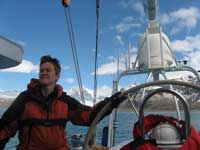
Image courtesy of the British Schools
Exploring Society’s expedition to
South Georgia
Alison McLure was born in Thurso, at the northernmost tip of Scotland, and grew up in Glasgow with physics as an integral part of everyday life: her parents – both enthusiastic physics teachers – would constantly talk about physics and ask their three children questions such as “Why do we all lean one way when the car is going around a roundabout?”. In school, Alison was especially impressed by the experiments her father conducted with the class (he was her teacher then). She was also taken by chemistry, with its flash-bang-smoke experiments, but her ties with physics were stronger, so she went on to study physics at Aberdeen University, as did her brother.
To Alison, real-life problems have always been the most appealing ones in science, particularly if finding a solution to them will make a difference. When she was young, Alison learned about the applicability of science first-hand: she used to sail a lot, and physics helped her to understand how the sails and the weather worked. This understanding of the intricacies of the weather also led Alison to her first job as a meteorologist with the Met Officew1. At that time, the Met Office liked to train its own people, so you didn’t need a degree in meteorology. Alison joined straight after graduating, hoping to do something practical, rather than conducting research. Ironically, she was posted to a research lab to start with: “Luckily, the research was to do with measuring the weather in extreme environments, so I got to put experimental automatic weather stations on top of mountains and on ocean buoys.”
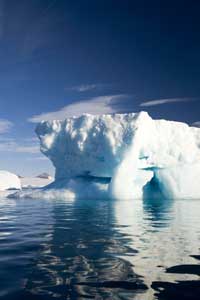
Hafermann / iStockphoto
As if this was too boring, Alison was selected to become a TV presenter for the weather on ‘Reporting Scotland’. She had been forecasting the weather at Aberdeen and London Weather Centres and a couple of Royal Air Force stations, so she was a reasonably experienced forecaster by that time. Besides, she had done a fair bit of local radio, so she had experience as a presenter: “My short spell on TV was with BBC Scotland to cover between one presenter leaving and the famous Heather the Weather arriving in 1994. My boss didn’t really give me a lot of choice. I was very nervous and wasn’t really cut out to be a glamour girl – I scraped off the makeup as soon as I finished my piece. Once I was recognised cycling home in a deluge. They probably thought that I had got the forecast wrong, but I just like cycling in the rain! It didn’t make the news, but I didn’t expect or want anyone to recognise me at all. That’s when I realised I wanted to give up.”
Those were exciting times: besides ending up on screen, Alison was offered the chance of a six-month secondment to the British Antarctic Surveyw2. She was lucky enough to pass the interview and after a month’s preparation, spent five fantastic months working at Rothera Research Station on the Antarctic Peninsula. Forecasting the weather in such an extreme environment was incredibly challenging, but Alison still managed to make time to climb, ski and watch the amazing wildlife. “Rothera is next to the sea on the Antarctic Peninsula, so it is not on the ice cap, which is all ice and snow and no wildlife. I went during the Antarctic summer, our winter, so I had three summers in a row. The base was pretty basic, but everything you needed was there. They had professional cooks, a library and a bar, and social evenings were arranged. During the day, all of us had our own jobs to do, and I was impressed by everyone’s professionalism. There were around 50 people on the base at the time – it’s busy in their summer and minimal staff in winter. I was the only woman there for most of the time, and living with so many men had its moments.
“My room was right next to the bar, so through the wall I could hear the shenanigans late into the night. I had to be first up in the morning to get the forecast sorted out, so eventually I moved out of that room and into a container outside… pretty chilly, but at least it was quiet. Tourist ships occasionally came to the base, which gave us a welcome change of conversation, although we had to laugh when one tourist stepped off the ship and asked what height we were at. I suppose they couldn’t get their head round the snow and ice at sea level.”
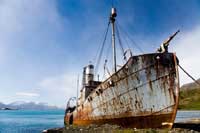
at the beach of Grytviken, South
Georgia, British Antarctic Survey
Station
Image courtesy of Alexander
Hafermann / iStockphoto
After ten years of the weather, Alison decided it was time for a change – in fact, quite a number of changes over the years. First, she worked as joint manager of a marina in the west of Scotland: “The marina had just been taken over by a new owner, and they were looking for new staff. Although I had no experience in working for a business, I persuaded them that I would learn quickly. Also, the yachties loved the fact that I would give them personal forecasts and knew a fair bit about boats. The job involved all sorts of things, from fixing and launching boats, and maintaining the infrastructure of the marina, to doing the books and accounting forecasts and making strategic decisions on the direction of the business.”
Three years later, Alison became a policy officer with the Scottish Governmentw3 in the Environment and Rural Affairs Department, a position she held for another three years.
“I was meant to find out as much as I could about beef and sheep in Scotland, so that I could advise the minister on any developments or potential issues. It also involved liaising with landowners, crofters and farmers to find out their concerns.”
Having now developed a taste for change, Alison moved jobs again, and spent another three years with the Scottish Leadership Foundationw4 before taking on her current job with the Institute of Physicsw5, where she has been since 2005. It was the mixture of experiences that Alison had gained over the years, within and outside science, which earned her this latest job – and she advises everyone to keep an open mind when applying for a position: “It is amazing how many transferrable skills you have as a scientist,” she says.
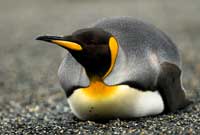
Image courtesy of Alexander
Hafermann / iStockphoto
However, working as the National Officer for the Institute of Physics in Scotland doesn’t leave time for boredom. “One day I might be talking to a member of the Scottish Parliament, and the next I could be making solar cookers with a class of students,” enthuses Alison. Her job involves organising events for members of the Institute of Physics in Scotland and promoting physics to anyone who will listen. “It would be great if I could show people what a great and fascinating time you can have if you take physics, at any level,” Alison says.
The main challenge that scientists face, according to Alison, is one of image: “People either think you are too clever by half, or that you must be like a cartoon scientist. Admitting to being a physicist isn’t really the best chat-up line, unfortunately. I think people struggle to understand what scientists do in their day-to-day job. Perhaps it is up to us to make ourselves more visible to the public. I certainly receive great feedback when I give talks about my time working in the Antarctic and the science that goes on there.
When people see the pictures and meet a real person, science becomes more tangible to them. If everyone had some grounding in science and how science works, perhaps that would help them to understand some of the issues which we face as a society.”
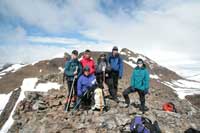
Georgia with Alison on the right
Image courtesy of the British
Schools Exploring Society’s
expedition to South Georgia
Alison doesn’t stop at hopes and words – she also takes action. In 2007, she was Chief Scientist on a British Schools Exploring Society (BSES)w6 expedition to the small island of South Georgia in the South Atlantic. “We surveyed penguin colonies, monitored glaciers, did plant surveys and meteorological readings, as well as general exploring and climbing mountains. BSES wanted to set up a project for gap-year students along with HMS Endurancew7, the UK Royal Navy’s ice patrol ship, and they agreed to support the project for five years, so that we could gather some meaningful data, rather than a snapshot of one year, which has limited value. There were 18 young explorers between 18 and 22 years old, and six leaders. Each year, there will be different young explorers and mostly new leaders, but the expeditions will follow a similar programme and run similar experiments.
I had applied to BSES to go on a Greenland expedition, but when they noticed that I had been to the Antarctic before, they asked if I would go on this project instead.” Alison would like to go back there in 2012, at the end of the five-year programme, to find out if the experiments she set up with the youngsters have yielded useful results.
Alison likes a life of change and a challenge – and this is also her attitude to science: “I enjoy the uncertainty of the journey – whatever piece of research you do, it turns up more questions than answers.” And this is the thrill, really.
Web References
- w1 – The website of the Met Office can be found here: www.metoffice.gov.uk
- w2 – The website of the British Antarctic Survey can be found here: www.bas.ac.uk
- w3 – To find out more about the Scottish Government, see: www.scotland.gov.uk
- w4 – For more information about the Scottish Leadership Foundation, see: www.lums.lancs.ac.uk/leadership/scotdip/slf
- w5 – To find out more about the Institute of Physics in Scotland, see: www.iopscotland.org
- w6 – You can find out more about the British Schools Exploring Society and the possibilities for participation here: www.bses.org.uk
- You can also read all about the BSES expedition to South Georgia in their blog: http://antarctica.physics.org
- w7 – To learn more about HMS Endurance, the UK Royal Navy’s ice patrol ship, see: www.royalnavy.mod.uk/server/show/nav.1843
Review
The importance of educating students about career possibilities for science graduates is rather underestimated in science education. Yet, providing students with an overview of possible career choices, other than working in a laboratory, will positively adjust their conceptions about science.
This narrative gives a rich, illustrative and realistic description of the life of a scientist, in which not only appealing career possibilities are explained, but also a variety of the transferable skills that scientists develop during their studies and careers are described. Furthermore, this interview explicitly portrays several research dispositions, such as being curious, or enjoying the uncertainty when doing research. Although these dispositions are highly valued by scientists, they too often stay hidden to students. This interview can positively influence students’ aspirations to engage in further study of science subjects. I would encourage all science teachers to present to their students this article and many other good examples of what scientists actually do. These kinds of authentic accounts will positively change students’ conceptions of science.
Roeland van der Rijst, Netherlands





